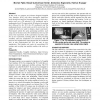Free Online Productivity Tools
i2Speak
i2Symbol
i2OCR
iTex2Img
iWeb2Print
iWeb2Shot
i2Type
iPdf2Split
iPdf2Merge
i2Bopomofo
i2Arabic
i2Style
i2Image
i2PDF
iLatex2Rtf
Sci2ools
100
click to vote
ISMAR
2002
IEEE
2002
IEEE
Alternative Tools for Tangible Interaction: A Usability Evaluation
In this work we compare an in-house designed Tangible User Interface (TUI) with three alternative single-user tools through an empirical investigation. These three alternative tools are a 3D physical, a 2D cardboard, and a mathematical tool. We expected the 3D physical to perform best, followed by the TUI, the 2D cardboard, and the mathematical tool. A pilot study was first carried out, the results of which were used to design a major experiment. Participants solved the same positioning problem, each using one of the four tools. The mathematical tool was not used in the experiment. In the experiment, trial time, number of user operations, learning effect in both preceding variables, and user satisfaction were measured. The 3D physical tool significantly outperformed the 2D cardboard tool. It also outperformed the TUI, but only in user satisfaction. This justifies the value of researching TUI systems and carrying out usability studies with such systems. Keywords Augmented Reality, Tang...
Related Content
| Added | 15 Jul 2010 |
| Updated | 15 Jul 2010 |
| Type | Conference |
| Year | 2002 |
| Where | ISMAR |
| Authors | Morten Fjeld, Sissel Guttormsen Schär, Domenico Signorello, Helmut Krueger |
Comments (0)

